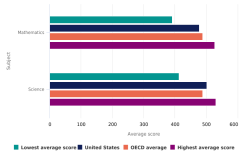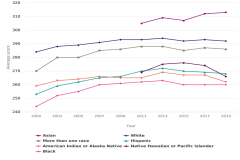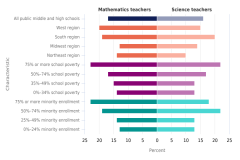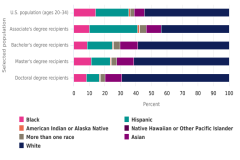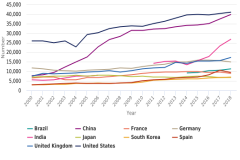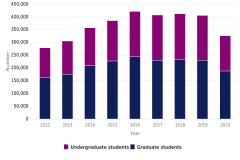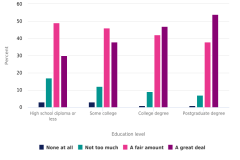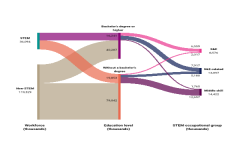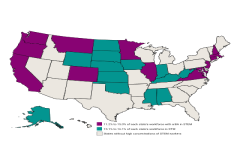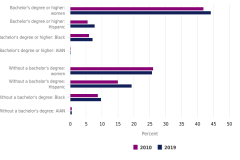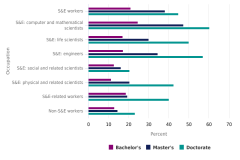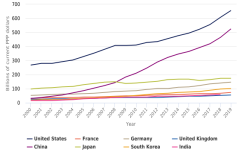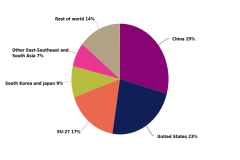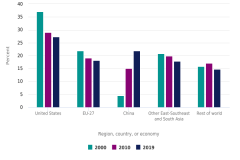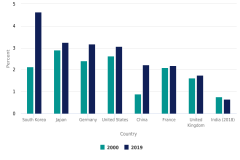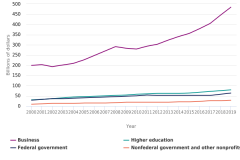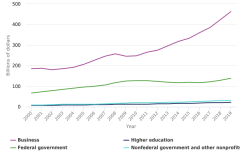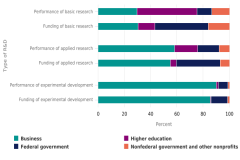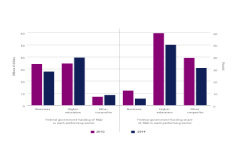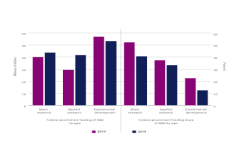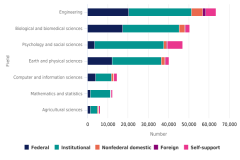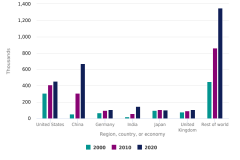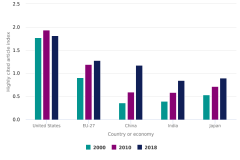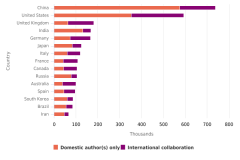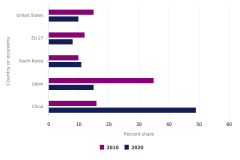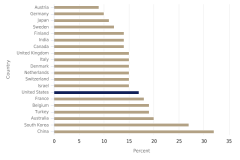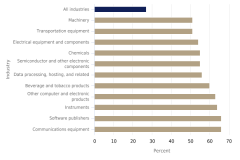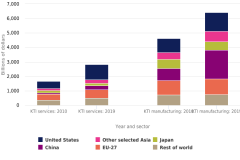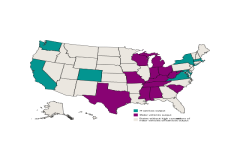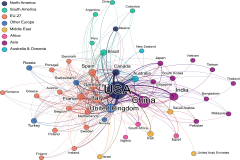| Figure 1 |
Average scores of 15-year-old students on the PISA mathematics and science literacy scales, by OECD education system: 2018 |
Organisation for Economic Co-operation and Development |
Program for International Student Assessment |
| Figure 2 |
Average scores of U.S. students in grade 8 on the NAEP mathematics assessment, by race or ethnicity: 2000–19 |
National Center for Education Statistics |
National Assessment of Educational Progress |
| Figure 3 |
Public middle and high school mathematics and science teachers with 3 years or less of teaching experience, by selected school characteristics: 2017–18 |
National Center for Education Statistics |
National Teacher and Principal Survey |
| Figure 4 |
Representation of race or ethnicity in the U.S. population and among S&E degree recipients: 2019 |
National Center for Education Statistics |
Integrated Postsecondary Education Data System (IPEDS), Completions Survey |
| Figure 4 |
Representation of race or ethnicity in the U.S. population and among S&E degree recipients: 2019 |
U.S. Census Bureau |
Population Estimates Program |
| Figure 5 |
S&E doctoral degrees, by selected countries: 2000–18 |
Eurostat |
Education and training database |
| Figure 5 |
S&E doctoral degrees, by selected countries: 2000–18 |
Government of India, Ministry of Education, Department of Higher Education |
All India Survey on Higher Education |
| Figure 5 |
S&E doctoral degrees, by selected countries: 2000–18 |
Ministry of Education, Culture, Sports, Science and Technology (Japan) |
Survey of Education |
| Figure 5 |
S&E doctoral degrees, by selected countries: 2000–18 |
Ministry of Education, People's Republic of China |
Higher Education Data |
| Figure 5 |
S&E doctoral degrees, by selected countries: 2000–18 |
National Bureau of Statistics of China |
China Statistical Yearbook |
| Figure 5 |
S&E doctoral degrees, by selected countries: 2000–18 |
Organisation for Economic Co-operation and Development |
Education at a Glance |
| Figure 6 |
International students in S&E enrolled at U.S. higher education institutions, by academic level: 2012–20 |
U.S. Department of Homeland Security, U.S. Immigration and Customs Enforcement |
Student and Exchange Visitor Information System (SEVIS) |
| Figure 7 |
Confidence in scientists to act in the best interests of the public, by education level of respondents: 2020 |
Pew Research Center |
American Trends Panel |
| Figure 8 |
U.S. workforce, by STEM occupational group and education level: 2019 |
U.S. Census Bureau |
American Community Survey |
| Figure 9 |
High concentration of STEM workers, by state: 2019 |
U.S. Census Bureau |
American Community Survey |
| Figure 10 |
Demographic composition of the STEM workforce: 2010 and 2019 |
U.S. Census Bureau |
American Community Survey |
| Figure 11 |
Foreign-born workers with a bachelor's degree or higher, by highest degree level and major occupation: 2019 |
National Center for Science and Engineering Statistics |
National Survey of College Graduates |
| Figure 12 |
Gross domestic expenditures on R&D, by selected country: 2000–19 |
National Center for Science and Engineering Statistics |
National Patterns of R&D Resources |
| Figure 12 |
Gross domestic expenditures on R&D, by selected country: 2000–19 |
Organisation for Economic Co-operation and Development |
Main Science and Technology Indicators |
| Figure 12 |
Gross domestic expenditures on R&D, by selected country: 2000–19 |
UNESCO Institute for Statistics |
UIS.Stat database |
| Figure 13 |
Contributions to growth of worldwide R&D expenditures, by selected region, country, or economy: 2000–19 |
National Center for Science and Engineering Statistics |
National Patterns of R&D Resources |
| Figure 13 |
Contributions to growth of worldwide R&D expenditures, by selected region, country, or economy: 2000–19 |
Organisation for Economic Co-operation and Development |
Main Science and Technology Indicators |
| Figure 13 |
Contributions to growth of worldwide R&D expenditures, by selected region, country, or economy: 2000–19 |
UNESCO Institute for Statistics |
UIS.Stat database |
| Figure 14 |
Shares of worldwide R&D expenditures, by selected region, country, or economy: 2000, 2010, and 2019 |
National Center for Science and Engineering Statistics |
National Patterns of R&D Resources |
| Figure 14 |
Shares of worldwide R&D expenditures, by selected region, country, or economy: 2000, 2010, and 2019 |
Organisation for Economic Co-operation and Development |
Main Science and Technology Indicators |
| Figure 14 |
Shares of worldwide R&D expenditures, by selected region, country, or economy: 2000, 2010, and 2019 |
UNESCO Institute for Statistics |
UIS.Stat database |
| Figure 15 |
R&D intensity, by selected country: 2000 and 2019 |
National Center for Science and Engineering Statistics |
National Patterns of R&D Resources |
| Figure 15 |
R&D intensity, by selected country: 2000 and 2019 |
Organisation for Economic Co-operation and Development |
Main Science and Technology Indicators |
| Figure 15 |
R&D intensity, by selected country: 2000 and 2019 |
UNESCO Institute for Statistics |
UIS.Stat database |
| Figure 16 |
U.S. R&D expenditures, by performing sector: 2000–19 |
National Center for Science and Engineering Statistics |
National Patterns of R&D Resources |
| Figure 17 |
U.S. R&D expenditures, by source of funds: 2000–19 |
National Center for Science and Engineering Statistics |
National Patterns of R&D Resources |
| Figure 18 |
U.S. R&D performance and funding, by type of R&D and sector: 2019 |
National Center for Science and Engineering Statistics |
National Patterns of R&D Resources |
| Figure 19 |
R&D performance funded by the federal government, by performing sector: 2010 and 2019 |
National Center for Science and Engineering Statistics |
National Patterns of R&D Resources |
| Figure 20 |
R&D performance funded by the federal government, by type of R&D: 2010 and 2019 |
National Center for Science and Engineering Statistics |
National Patterns of R&D Resources |
| Figure 21 |
Full-time doctoral students in S&E, by field and primary source of support: 2019 |
National Center for Science and Engineering Statistics |
Survey of Graduate Students and Postdoctorates in Science and Engineering |
| Figure 22 |
S&E articles, by selected region, country, or economy: 2000, 2010, and 2020 |
Elsevier |
Scopus |
| Figure 23 |
Highly cited article index, by selected country or economy: 2000, 2010, and 2018 |
Elsevier |
Scopus |
| Figure 24 |
International collaboration on S&E articles for the 15 largest producers of S&E articles, by country: 2020 |
Elsevier |
Scopus |
| Figure 25 |
Shares of international patents granted to inventors, by selected country or economy: 2010 and 2020 |
European Patent Office |
PATSTAT |
| Figure 26 |
Share of Patent Cooperation Treaty applications with at least one woman listed as inventor, by country: 2019 |
World Intellectual Property Organization |
Intellectual Property Statistics |
| Figure 27 |
Share of U.S. companies reporting product or process innovation, by selected industry: 2015–17 |
National Center for Science and Engineering Statistics |
Annual Business Survey |
| Figure 28 |
Output of KTI industries for selected region, country, or economy, by sector: 2010 and 2019 |
IHS Markit |
Comparative Industry Service |
| Figure 29 |
High concentration of motor vehicle manufacturing and information technology (IT) services output, by state: 2020 |
U.S. Bureau of Economic Analysis |
GDP by State |
| Figure A |
Collaboration network on coronavirus-related articles, by country: 2020 |
Elsevier |
Scopus |
 An official website of the United States government
An official website of the United States government

